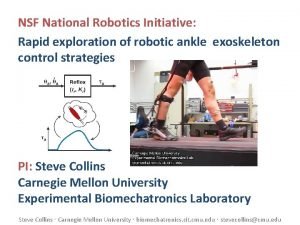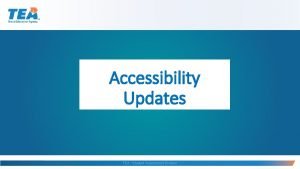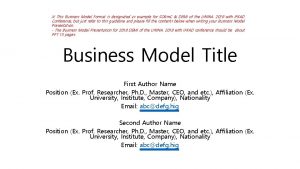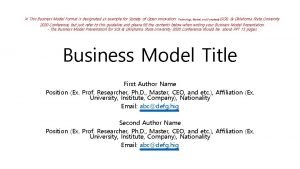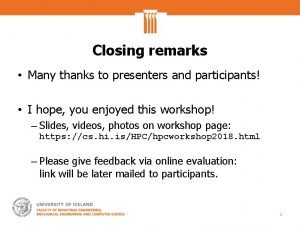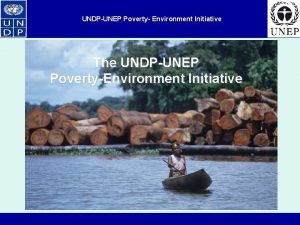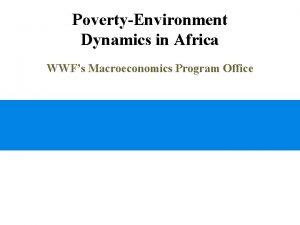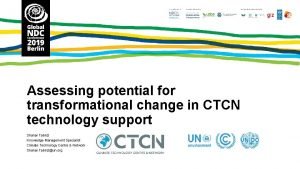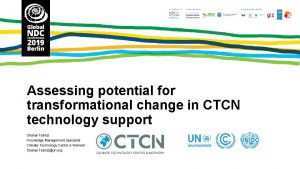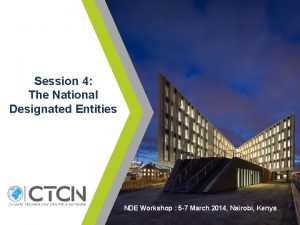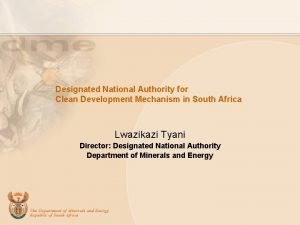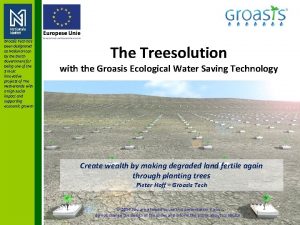POVERTYENVIRONMENT INITIATIVE CTCN TRAINING WORKSHOP OF NATIONAL DESIGNATED
















- Slides: 16

POVERTY-ENVIRONMENT INITIATIVE CTCN TRAINING WORKSHOP OF NATIONAL DESIGNATED ENTITIES Overview of Gender and Climate Change Climate vulnerable livelihood in Garissa, Kenya © John van Mossel ALP 2012 Presentation by Thérèse Niyondiko, Programme Officer/PEF

Overview of the Presentation 1. Introduction – Objectives of the session – Why hould we consider Gender in CC Responses ? 2. Mainstreaming Gender in CC: Approaches and tools - Some definitions - Approaches and tools - Some Examples

1. Introduction: Session Objectives : • To enable us have a common understanding of gender as a concept and gender mainstreaming as a strategy in the context of Climate Change. • To continue raise awareness on the necessity/importance of gender responsive planning, monitoring and evaluation of CC related Programmes. Result : A common understanding of: • the rationale of integrating gender and other equity issues in Climate Change related activities • How better to mainstream them and which tools can be used ?

1. 2 Why Gender is important to CC? Climate change is threatening the livelihoods of women and men- wide-ranging impacts on freshwater, resources, food, forest products , human health etc. • Poor and marginalized segments of society are especially vulnerable to the adverse effects of climate change - tend to have limited resources - limited capacity to adapt • livelihoods tend to be highly dependent on natural resources that are sensitive to climate vulnerability For example, agriculture-a highly climate-sensitive • Climate change may also accentuate existing inequalities including access to land other assets – limited ability of women to respond to the effects of CC •

1. 2 Why Gender is Important in CC? • Gender equality leads to economic growth and contributes to poverty alleviation • Gender equality is a basic human right for both men and women to access to land, water, forests and other productive resources including technologies to adapt to CC • Participation and inclusion of women and marginalized groups - different perspectives and make climate responses more effective and sustainable.

1. 3 IMPACT ON WOMEN Impacts on women CROP FAILURE FUEL SHORTAGE Climate Change SHORTAGE OF SAFE, CLEAN WATER RESOURCE SCARCITY Household food provision; Increased agricultural work Household fuel provision; food-fuel conflicts Household water provision; exposure to contaminated sources Economic drawbacks; lack of land tenure; resource-dependent livelihoods; school dropouts, early marriage NATURAL DISASTERS Greater incidence of mortality; reduction of life expectancy DISEASE Lack of access to healthcare; increased burden of caring for young, sick and elderly DISPLACE-MENT Loss of livelihoods; lack of adequate shelter; conflicts CIVIL WAR / CONFLICT Loss of livelihoods and lives; sexual violence and trauma Adapted from WEDO, 2008

2. 1 Mainstreaming Gender in Climate Change: Definitions • Gender mainstreaming is a strategy for ensuring that the different needs, views and perceptions of women and men, girls and boys are taken into account in planning , design , implementation and monitoring and evaluation. • Mainstreaming is not about adding a ‘woman’s component’ or even a ‘gender equality’ component into existing activities or projects. It means bringing the experiences, knowledge, and interests of women and men in development interventions including those related to CC adaption/mitigation.

2. 2 Mainstreaming Gender: Systematic gender analysis • Design and Project implementation – Goals/objectives refer to gender issues – Participation/engagement – Training/awareness raising – Budgeting and financing • Monitoring and evaluation – Does project affect activity profile ? – Does project change access/control ? – Does project improve both condition/position ? – Gender disaggregated data

2. 3 Mainstreaming gender in climate change : approaches and tools • Applying existing Tools – see relevant guidance notes – PEI gender equality checklist for programme formulation which includes CC component – Tools available through partner organizations including UNDP, UNWomen and others • Applying Gender based Programmatic Approach: – Finding the entry points and making the case for gender and equity issues – Integrating inclusive CC issues into national development processes – Meeting the implementation challenge to mitigate/adapt to climate change

Finding entry points and making the case for Gender and equity issues – Preliminary Assessment • understanding governmental, political and institutional needs to promote gender equality and specific gender-sensitive Climate response • gender analysis of relevant (sub)-national and sector strategies, plans, budgets and aid programmes –in line with existing gender equality strategies. • Impact analysis of socio economic aspects of climate change- loss in GDP, land degradation, who is more affected? • Raising awareness and building partnerships – (sub)national steering groups include representatives of women and marginalised groups. – communication strategy that includes outputs related to gender equality and invest in community sensitization i. e Education on Climate sciences, early warning systems, Hard adaptation strategies- diversification of crops , technology

The importance of access to information on CC. - www. careclimatechange. org

Integrating inclusive CC into national development processes • Developing country-specific evidence including gender disaggregated data – EIA, Environment and Social Impact Assessment (ESIA), PEER and economic assessments with provision of gender analysis- • Influencing policy processes – (sub)-national and sector plans on CC integrate gendersensitive objectives that address concerns of marginalized groups to climate change. • Developing and costing policy measures • make the case for gender and equity inclusion by highlighting the positive effects of inclusive/gender-sensitive planning and budgeting for effectiveness of CC policies • Strengthening Institutions and Capacities

Some Examples: Mali • UNDP, UNIDO and IFAD initiated a programme to decrease the burden of fuel collection by supplying labour -saving energy services and promoting the empowerment of women by supplying multifunctional platforms to rural villages. The multifunctional platform is an engine with modular components that can supply motive power for time- and labour-intensive works such as agricultural processing (milling, de-husking) and electricity for lighting (approximately 200– 250 small bulbs), welding, or pumping water. • Benefits include time saving for women and that can be utilised for income generating activities for example. Source: UNDP-GGCA (2012)

Some examples: Rwanda “The switch to greener forms of growth offers new opportunities to promote gender equality and women’s empowerment. UNDP recently launched the Women’s Green Business Initiative to promote women’s entrepreneurship opportunities in climate change adaptation and mitigation. The Initiative works closely with women in developing countries to start, incubate or scale-up business enterprises, and improve their access to climate funds in a new green economy. By promoting business activities managed by women, it intends to help them to establish sustainable livelihoods, protect critical eco-systems and strengthen the resilience of communities to climate change. An example of how this initiative works is the local women’s group Twiyubake Turengara Ibidukikije (‘Empowering Ourselves in Order to Protect the Environment’) in Rwanda. In 2008, the UNDP Gender Team offset the GHG generated by their travel to a meeting in Rwanda by providing a voluntary credit grant of $10, 420 to the group for a bamboo-growing project. The women used the grant to plant 60 hectares of bamboo trees for use in making furniture, baskets and handicrafts. Besides off setting the GHG emissions from the meeting, the project is reducing deforestation and erosion in the Nyungwe Forest National Park, and offers the women a stable income. ” Source: UNDP (2009)

PEI Africa Gender Strategy: Consolidating Partenerships • Objective: – The strategy aims to operationalize the guidance note on gender equality trough concrete measures to be taken by PEI Africa for better integration of a gender equality approach in 2014 -2017. • Proposed measures – increased collaboration with UN Women at the regional as well as country level – Increased collaboration with UNDP Gender initiatives such as the Gender and Economic Policy Management Initiative (GEPMI) – Capacity building of project staff to mainstream gender into the implementation of PEI. i. e. training on gender and CC-UNDP and GGCA – can involve NDEs – to provide suggestions of potential entry points for integrating gender and equity issues at country level. - i. e NDEs while developing, selecting and submitting country requests to the CTCN.

THANK YOU www. unpei. org
 Designated teacher training
Designated teacher training Kevin thompson nsf
Kevin thompson nsf National math and science initiative ap biology
National math and science initiative ap biology Usfws designated ports
Usfws designated ports Uscis civil surgeon locator
Uscis civil surgeon locator Accessibility features tea
Accessibility features tea Designated format
Designated format A is a work area designated and clearly marked in which
A is a work area designated and clearly marked in which Integrated eld vs designated eld
Integrated eld vs designated eld Jcids manual
Jcids manual Designated eld lesson plans
Designated eld lesson plans Utiitsl psa registration
Utiitsl psa registration Designated format
Designated format Flight examiners handbook
Flight examiners handbook Uscis i693
Uscis i693 Motivation letter workshop
Motivation letter workshop Closing remarks for a training workshop
Closing remarks for a training workshop

